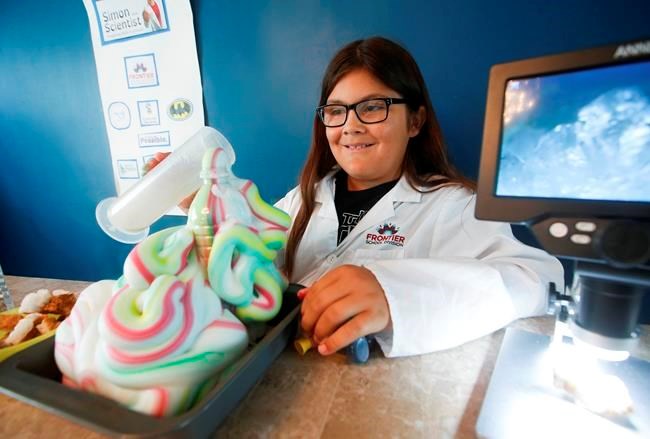A single eagle feather sits on the kitchen table in Simon Monteith's home.
Next to it is an array of household products including hydrogen peroxide, dish soap, food colouring and a baking dish.
The scene depicts the two worlds the nine-year-old walks.
From a science perspective, feathers aid in thrust, enabling flight. From a First Nations perspective, an eagle feather is a symbol of respect.
"I like to look at things from two or more perspectives," says Simon.
For the past two years, the Cree youth from Opaskwayak Cree Nation in northern Manitoba has been virtually inviting others into his Winnipeg home to share his love of all things science related.
Using his kitchen as a backdrop, Simon has produced roughly 60 educational videos and posted them to social media under the moniker Simon The Scientist.
The project started at the beginning of the COVID-19 pandemic, when Simon approached his mom about creating a video to help explain the virus to other children and youth. It expanded into content on geology, technology and chemistry.
Jacqueline Monteith says her son has always had the ability to understand complex concepts in an original way.
"It's fascinating that a kid has a unique ability to teach scientific concepts or complex concepts to other children in a very unique way. Kids teaching kids is a way that children will understand as opposed to adults trying to teach children," says Monteith.
Simon's love of science came at an early age.
"It wasn't really a specific thing that made me interested in science. It's just sort of who I am," he says.
Simon hopes to reach groups who are under-represented in the sciences field.
For Rob Cardinal, this same goal was what prompted him to help found IndigeSTEAM, an organization providing Indigenous-led and culturally relevant programming to Indigenous youth and other under-represented groups.
The organization takes its name from the acronym STEM: science, technology, engineering and mathematics. The group incorporates arts, architecture and agriculture in their programming to form STEAM. This represents areas where Indigenous peoples have been innovators for thousands of years.
"Knowledge is knowledge. Our ways and culture are so applicable in these times," says Cardinal.
A 2020 study from the Conference Board of Canada found Indigenous students are more engaged with a curriculum that bridges Indigenous ways of knowing with Western science.
The board tracked more than 100 different programs in Canada aimed at helping Indigenous learners succeed in STEM. The study found while there has been a push to reach Indigenous students in early years, there is still a gap in preparing students in high school for post-secondary studies in STEM.
Indigenous people make up four per cent of adults in Canada, but less than two per cent of those working in STEM.
There is a lack of financial, technical and community resources, says Doug Dokis, director of Actua's Indigenous Youth in STEM program.
The national education organization is one of the country's largest STEM outreach organizations. It has built relationships with 200 Indigenous communities to provide programming to about 35,000 youth.
While work is being done on the ground and through various programs, there still hasn't been a cohesive national effort to improve Indigenous educational outcomes and participation in the STEM fields, added Dokis, who is Anishinaabe from Dokis First Nation in Ontario.
Dokis says in recent years, the industry has relied on Indigenous knowledge when it comes to climate and land sustainability.
"Indigenous people have always known about STEM at the highest level. Indigenous knowledges are now becoming a focal point for addressing some of the current social, environmental and economic challenges that society as a whole in Canada faces."
Cardinal says it's important for Indigenous youth to have role models.
Cardinal is Blackfoot from Siksika First Nation and an astrophysicist. After discovering a comet, Cardinal says one of his elders told him that he had an obligation to his nation to share his knowledge, prompting him to shift into a mentorship role.
Cardinal hopes to show youth there is a space for them in the sciences.
"Give them some inspiration and give them some pride."
Back in Winnipeg, Simon is becoming a mentor in his own right.
He wants to turn his passion project into a television show to reach more youth. He has submitted a business plan to Pow Wow Pitch, a competition for Indigenous entrepreneurs, and is a semifinalist.
“(I want to) help support the ideas of other kids so they can do what they want, which might not be science or might be science, but I want to help kids find their dream.”
This report by The Canadian Press was first published Aug. 27, 2022.
Brittany Hobson, The Canadian Press




